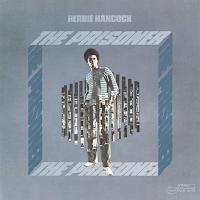Home » Jazz Articles » Album Review » Herbie Hancock: The Prisoner
Herbie Hancock: The Prisoner
The setting is a nonet and is pretty much a direct extension of the concept explored in Hancock's previous Blue Note album Speak Like a Child. Where that session found him experimenting with the timbral possibilities of the unusual front line of flugelhorn, alto flute and bass trombone, here he expands the instrumentation by adding the three further winds of flute, bass clarinet and trombone. The resulting texture is rich and full and with Hancock's unique writing the overall effect is quite unlike anything heard elsewhere.
Besides the expanded instrumentation, another important aspect is the soloists. On Speak Like a Child Hancock was the only soloist, with the wind players performing composed charts, whereas on The Prisoner, besides their role within the complex wind writing, Joe Henderson, Johnny Coles and Garnett Brown all receive solo space.
In every respect "I Have a Dream" is the standout track. Hancock's tribute to Martin Luther King is compositionally utterly beautiful, with Henderson's alto flute floating in and out of the shimmering layers of winds in the head sections. The solos by Hancock, Coles on flugelhorn and Henderson on tenor saxophone both contrast and compliment each other perfectly. Henderson in particular is in his element here putting in one of his finest recorded solos. The way the head then gradually rebuilds from a single sustained trombone note, thickening in texture with the introduction of the other winds, is masterful.
Special attention must also be paid to the rhythm section pairing of bassist Buster Williams and drummer Tootie Heath. Williams' full bass tone and solid lines provide a firm grounding for the group. Heath is on inspired form. His rim-shots and tom accents, combining elements of Latin rhythm with free, expressive playing, as well as his attention to dynamics all contribute strongly to the success of "I Have a Dream."
The recording quality of this session is another factor that must be pointed out. Rudy Van Gelder creates a perfect balance between the winds and the rhythm section, as well as really bringing out the soloists with clarity. Quite unusual for a Blue Note session of this period is the use of reverb, most notably on Coles' flugelhorn and Henderson's tenor sax.
Overall, a thoroughly recommended record, marking the end of an era in Hancock's discography but at the same time showing hints of some of the harmonic and instrumental concepts that he was soon to explore with the Mwandishi group.
Track Listing
1. I Have a Dream, 2. The Prisoner, 3. Firewater, 4. He Who Lives in Fear, 5. Promise of the Sun, 6. The Prisoner (alternate take), 7. Firewater (alternate take)
Personnel
Herbie Hancock
pianoJohnny Coles - Flugelhorn; Garnett Brown - Trombone; Joe Henderson - Tenor Saxophone, Alto Flute; Herbie Hancock - Piano, Electric Piano; Buster Williams - Double Bass; Albert "Tootie" Heath - Drums; Hubert Laws - Flute (tracks 1,2,4,6); Jerome Richardson - Bass Clarinet (tracks 1,2,4,6), Flute (tracks 3,5,7); Romeo Penque - Bass Clarinet (tracks 3,5,7); Tony Studd - Bass Trombone (tracks 1,2,4,6); Jack Jeffers - Bass Trombone (tracks 3,5,7)
Album information
Title: The Prisoner | Year Released: 2004 | Record Label: Blue Note Records
< Previous
All The Way Live
Next >
Exponentially Monk
Comments
Tags
Concerts
For the Love of Jazz
 All About Jazz has been a pillar of jazz since 1995, championing it as an art form and, more importantly, supporting the musicians who create it. Our enduring commitment has made "AAJ" one of the most culturally important websites of its kind, read by hundreds of thousands of fans, musicians and industry figures every month.
All About Jazz has been a pillar of jazz since 1995, championing it as an art form and, more importantly, supporting the musicians who create it. Our enduring commitment has made "AAJ" one of the most culturally important websites of its kind, read by hundreds of thousands of fans, musicians and industry figures every month.



















